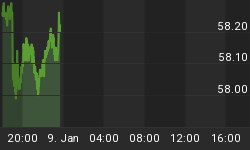NEW YORK, NY (KWR) August 10, 2011 - No one can blame investors for feeling like 2008 is back. After all, there has been a return to acute market volatility, financial and industrial stocks have been beaten up, and the VIX was up 7.93 points today, reaching 42.99. The Dow is down a little over 7% for the year. With the exceptions of gold and silver, commodities have also undergone a brutal re-pricing. Additionally, the panic mode has sent gold to all time highs (it ended the day close to the record at $1792.70), bolstered the Swiss franc and made the U.S. investment grade corporate bond market a relative safe harbor especially in the plain vanilla industrial names. What do we take from this market upheaval?
1. Credit, equity and commodity markets are pricing in a recession. U.S. economic data has been signaling that the "soft patch" may be something more significant - a stall that could well turn into a recession. This explains the re-pricing in those sectors associated with economic growth - mining, materials, oil & gas, retail (clothing), and infrastructure. Financials, the villain at the heart of the drama in 2008, are also under pressure in both spreads and stock prices. (This was also pushed by a degree of contagion from French banks and concern over their exposure to peripheral European economies.) Bank of America 5-year CDS ended the day at 300/310 and its stock was at $6.77 (down from a high in the year of $14.89 on February 14).
2. While the S&P downgrade of the U.S. to AA+ was the spark that appears to have lit the market explosion, it is not the core reason. The core reason is that the US and other advanced economies are in the middle of a multi-year process of deleveraging. This is impacting the public sector and households. The S&P downgrade only underscored that the U.S. political establishment did a very poor job in dealing with a problem that was well-identified and had considerable time before the August 2nd deadline.
3. Although the market re-pricing is brutal, it comes at a time when U.S. corporate strength is solid. Earnings over the last quarter were good, with far more positive surprises than negative. Moreover, earnings forecasts for the rest of the year depicted a degree of caution, not Armageddon. It is often forgotten, but market upturns and downturns tend to overshoot.
4. The U.S. banking sector is in better shape now than it was in 2008. Although banks and other financial companies have been pummeled in the market downturn, there has been a considerable effort to reduce toxic assets, rebuild balance sheets and stockpile reserves. Creditsights (August 10, 2011) observed: "The takeaway message is that the large banks and brokers should have sufficient liquidity resources to manage through these market dislocations caused by S&P's sovereign downgrade." Significantly, Bank of America, one of the bank's most beaten up in the downturn, reported in Q2, 2011 that it has global excess liquidity sources totaling $402 billion, up $66 billion (+20%) from year-end 2010. The bank had reserve repo assets of $235 billion, versus repo liabilities of $240 billion, for net liabilities of $4 billion. This means that net liabilities were a manageable 1%.
5. There is a path out of the downturn. What will make a difference in this market panic is traction on the economic policymaking front. If nothing else the S&P downgrade and ensuing global market sell-off penetrated the seemingly thick cranial zones of Washington's political elite, providing a very good reason to take fiscal consolidation more seriously. One bell-weather is who is appointed to the six-person Congressional committee on fiscal consolidation by the Republicans. The Democrats have picked relatively reasonable politicians. Now it is up the Grand Old Party. If it appears that this is a group of pragmatic and serious individuals, such an action could help stabilize markets. Equally important, a more coordinated G-7 or G-20 response to the crisis would have considerable currency in taming the uncertainty, though this could have to wait until the Europeans are back from vacation or the crisis becomes even more intense (enough to interrupt vacation plans). Such a response would indicate that the G-20 are willing to pool their resources (like they did in 2009) to help backstop market turmoil, which means perhaps greater support for the IMF in its help for Europe. Without providing a more well-defined exit strategy for Europe in its sovereign debt crisis, that region remains the major risk factor to global recovery.
There is no easy path from the deleveraging process. Like Latin America in the late 20th century, the way forward is painful structural adjustment in the economy and a return to living within one's means. It took Latin America close to two decades to get back on the right track, but the most difficult part of that process was the recognition that tough decisions had to be made and stuck to. This is where the U.S. and European societies are - grappling with painful judgments over what they can afford after fostering decades of entitlement cultures. Consequently, what begins to put things on the right track is a more serious and less politicized approach to economic policymaking in the days ahead. A little traction in this direction begins to reduce the uncertainty and that would be a good way to start the fall.
















